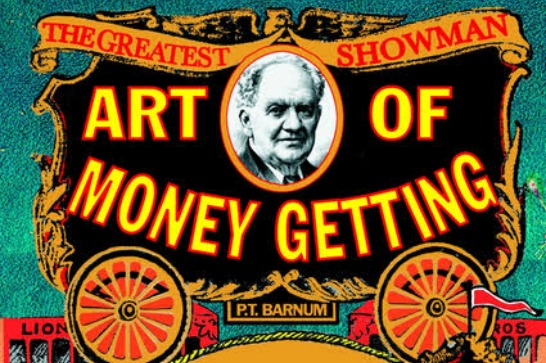P.T. Barnum’s Forgotten Book “The Art of Getting Money” – Ch. 7
We are doing a series here at BBH on The Art of Getting Money, a little-know book from P.T. Barnum wrote back in 1880.
Why? A couple reasons. First, because there’s a movie coming out December 25, 2017, starring Hugh Jackman, called The Greatest Showman.
It’s a musical about the life of P.T. Barnum.
I don’t know a lot about the movie yet, but it looks pretty good from what I’ve seen in the trailer…
The Greatest Showman – Official Trailer
P.T. Barnum’s Little-Known Book from 1880
So I thought it’d be cool to feature his little-known book The Art of Money Getting or Golden Rules for Making Money (It’s in the public domain, so it’s ok for me to post it on this site)
Some of you might not know this, but Barnum is FALSELY known for saying, “There’s a sucker born every minute,” (He actually didn’t say that.)
The second reason I thought it would be good to do this is series is because this book contains some surprisingly practical and helpful advice on how everyday people can better manage their income and increase their wealth.
The book is 137 years old, but much of the advice he gives is still applicable to all of us today.
That’s why I’ve decided to post a new segment of the book once a week here on BayBusinessHelp.com.
Today you will be able to read chapter 1 about choosing your vocation (i.e. what you do for a living).
Reminder of 4 Things Before You Read the Book
1. DISCLAIMER:
I don’t agree with everything that P.T. Barnum did during his life.
I also don’t agree with every single thing he wrote in his book.
I don’t even agree that wealth is, or should be, the primary goal in life. (There are plenty things that are more important than wealth!)
But I DO believe that all of us can benefit from learning how to better handle the money (however small or great) that flows in and out of our hands.
And this book contains some advice that I think you will find both interesting and helpful for you when it comes to how to better handle your money.
2. MY ADVICE TO READERS:
Take the good advice and leave the bad!
3. THE ONLY CHANGES I’VE MADE:
The only changes I’ve made to the text are:
- I’ve broke many of the paragraphs into smaller chunks of text to make it easier to read.
- I’ve also bolded or italicized sections of the text to help them stand out to the reader.
- I also occasionally include a modernized word to help the reader understand an old school word or phrase that Barnum uses.
- And I’ve also added some headers to the text, made some quotes stand out, and bulleted some of his points to make sections stand out for the reader.
4. SOME OF IT MIGHT BE OFFENSIVE
Because of the way spoke and thought back in the 1800’s compared to now, you shouldn’t be surprised if some of the content is offensive to our current standards and way of thinking.
If you can’t just ignore this, like I do, and you will be offended, then you probably shouldn’t read any of the posts from this series. 🙂

What We’ve Covered So Far
If you missed the previous posts in this series, you can read them here:
Introduction to The Art of Money Getting
— The Art of Money Getting – Chapter 1: Right Vocation
— The Art of Money Getting – Chapter 2: Right Location
— The Art of Money Getting – Chapter 3: Avoid Debt
— The Art of Money Getting – Chapter 4: Persevere
— The Art of Money Getting – Chapter 5: Whatever You Do, Do It With All Your Might
— The Art of Money Getting – Chapter 6: Depend Upon Your Own Personal Exertions
Today’s chapter is a short one.
But it contains some very important information about using the best tools in business.
And these are the kind of tools that WON’T fit in any toolbox!
I think you’re going to really like it, so let’s get right to it…
— The Art of Money Getting: Chapter 7: USE THE BEST TOOLS —
Men in engaging employees should be careful to get the best.
Men in engaging employees should be careful to get the best. Understand, you cannot have too good tools to work with, and there is no tool you should be so particular about as living tools.
If you get a good one, it is better to keep him, than keep changing.
He learns something every day; and you are benefited by the experience he acquires. He is worth more to you this year than last, and he is the last man to part with, provided his habits are good, and he continues faithful.
If, as he gets more valuable, he demands an exorbitant increase of salary; on the supposition that you can’t do without him, let him go.
Whenever I have such an employee, I always discharge him; first, to convince him that his place may be supplied, and second, because he is good for nothing if he thinks he is invaluable and cannot be spared.
But I would keep him, if possible, in order to profit from the result of his experience.
An important element in an employee is the brain. You can see bills up, “Hands Wanted,” but “hands” are not worth a great deal without “heads.” Mr. Beecher illustrates this, in this wise:
An employee offers his services by saving, “I have a pair of hands and one of my fingers thinks.” “That is very good,” says the employer.
Another man comes along, and says “he has two fingers that think.” “Ah! that is better.”
But a third calls in and says that “all his fingers and thumbs think.” That is better still.
Finally another steps in and says, “I have a brain that thinks; I think all over; I am a thinking as well as a working man!” “You are the man I want,” says the delighted employer. — Henry Ward Beecher
Henry Ward Beecher
Those men who have brains and experience are therefore the most valuable and not to be readily parted with; it is better for them, as well as yourself, to keep them, at reasonable advances in their salaries from time to time.

